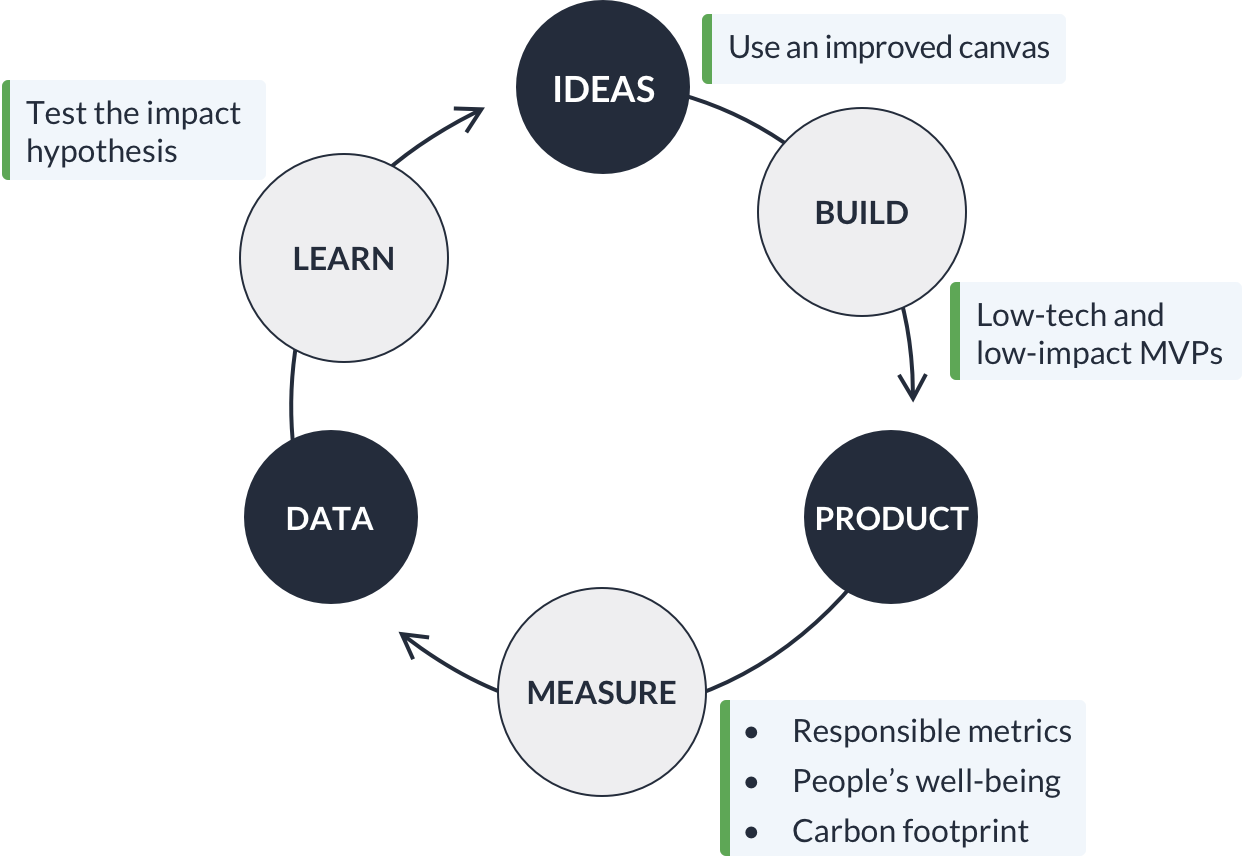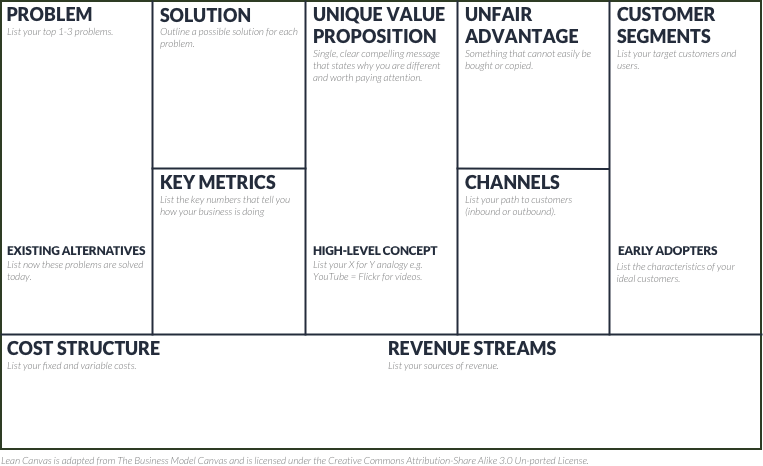The Lean Startup is a methodology that helps startups shorten their product development cycles and quickly adapt to customer needs as they search for sustainable business models. The methodology is described in greater detail in the book The Lean Startup by Eric Ries, which helped popularize the principles of the methodology. The Lean Startup is now the common language of startups and startup schools worldwide, making it a great starting point to introduce responsible thinking to the next generation of startup founders.
Build-Measure-Learn feedback loop
The essential element of the methodology is the Build-Measure-Learn feedback loop a startup should try to run through as quickly as possible.

The loop usually starts with the initial ideas, which include assumptions and hypotheses about a problem the startup would like to solve. From there, the startup quickly builds a minimum viable product (MVP) – often using agile software development – to test the initial hypothesis through experimentation. As people use the product, the startup measures key metrics – using innovation accounting methods –, so that the team learns from the collected data and decides whether to pivot (change direction) or persevere on the current path, thus starting the feedback loop all over again.
Let’s take a look at the core principles of the methodology to see how responsible product development could lead to more responsible decisions.
Initial startup vision and strategy
A startup team often comes together with a bold vision on how to create a world-changing business. As the vision rarely changes, this is the first opportunity for a startup to choose a more responsible destination.
A responsible vision should focus on improving the well-being of the people and the planet, not just introduce more technology for its own sake. Technology is exciting and often useful, but we must recognize that more technology isn’t inherently better on its own.
The next important step for a startup is to figure out how to turn the vision into a strategy that will eventually lead to an actual product. These two parts are more likely to change as the startup moves through the feedback loop. The strategy might change once the startup decides it’s time for a pivot, while a product keeps changing through optimization as the startup keeps learning.
The Lean Canvas
A key part of defining the startup’s strategy is its business model. Filling in the Business Model Canvas or the Lean Canvas – the simplified adaptation designed specifically for early-stage startups – is often one of the first assignments for teams enrolled in startup schools around the world. Either version of the canvas helps a startup define its initial value proposition and other parts of its business model.
We discuss the Business Model Canvas in more detail in the Business Model Generation section. The Lean Canvas, created by Ash Maurya and shown below, comes with similar concerns: the social and planetary costs of the business model are not part of the picture.

It’s much easier to change the business model when the startup is still in the early experimentation phases. For this reason, a responsible startup should use one of the improved business model canvases that expose environmental & social costs and assumptions when defining its business model.
Validated learning and experimentation
The core activity of the Lean Startup methodology is running experiments to test various assumptions a startup has to make about its problem and solution. The original methodology categorizes assumptions into:
- the value hypothesis, which “(…) tests whether a product or service really delivers value to customers once they are using it” and
- the growth hypothesis, which *“(…) tests how new customers will discover a product or service”.
We suggest introducing a third hypothesis: the impact hypothesis. This hypothesis should test whether a product or service has a positive impact on the environment, the people involved in its supply chain, and the people indirectly affected by the product or service.
Startups usually assume they’ll have a positive impact on the world, but this optimistic impact hypothesis is almost never tested. For this reason, a modified business model canvas would be useful to surface the hidden assumptions about the impact of the product or service the startup envisions. (See the discussion about the Lean Canvas in the previous section.)
Minimum viable product (MVP)
In the Lean Startup methodology, MVPs are built quickly to test various hypotheses as fast as possible. Often, MVPs include low-tech solutions with a lower environmental impact. This approach is an excellent way to minimize waste during the initial phases when a startup might often change direction (pivot).
A responsible startup can do even more by using MVPs to test assumptions about the social and environmental costs of product ideas. When doing user research, we should dig deeper into how the product potentially affects people’s well-being and include responsible metrics when evaluating MVPs.
Innovation accounting and actionable metrics
To keep track of whether a startup is making progress, the Lean Startup methodology introduces the following learning milestones:
- Establish the baseline: a startup should start by building an MVP to “test most of startup’s assumptions and establish baseline metrics for each assumption simultaneously.”
- Tuning the engine: once the baseline is established, a startup should start experimenting with the goal of improving the chosen metrics.
- Pivot or persevere: after each experiment, the startup evaluates the results across chosen metrics, and the team needs to decide whether to pivot (change direction) or persevere on the current path.
It’s clear that choosing the right metrics is an essential part of the Build-Measure-Learn feedback loop. Vanity metrics that look good in pitch decks lead startups away from good business decisions. This is why metrics used in innovation accounting should be: actionable, accessible, and auditable.
We propose another requirement for metrics: responsible. A responsible metric is one that is chosen after considering questions such as:
- What are we taking away from people’s lives by optimizing for this metric?
- Are we improving people’s well-being, or are we increasing consumption and creating more waste?
- What would be the carbon footprint of achieving the metric, and is the value we provide worth it?
For example, people might be sharing a lot of content in a new social service the startup is developing, and the average time on site is also increasing, which is good for business. However, before choosing these metrics as the start’s North Star, a team should have a discussion on whether more content is actually improving the service and whether the content-sharing functionality provides value to people, or whether it creates more digital waste.
The early stages of a startup are a great time to be more selective with the solutions we decide to pursue as the team is still unburdened by legacy decisions and investor demands.
Growing and adapting
At any stage of a Lean Startup, it’s important for the company to keep adapting to market feedback and varying conditions. In terms of software development, a lean startup will likely rely on agile approaches (discussed in greater detail in the Product development section). We can easily modify various agile tools such as user stories to include responsible principles.
While software development usually plays a key role in tech startups, other departments in the company (design, QA, support, marketing, HR etc.) should also modify their processes to be more agile and more responsible. Every part of product development is important, as well as the conditions under which the work takes place – both internally and among contractors and suppliers – if we want to pave the way to a more responsible tech industry.
As the startup grows, it’s crucial to make responsible product development part of the company culture across departments as early as possible. Again, it’s way easier to set the right tone when the company is still small and agile than changing the way things are done in a large corporation.
Engines of growth
The Lean Startup methodology talks about fine-tuning the startup’s engine of growth: it’s the primary way a startup gets new customers. The Lean Startup defines three main types of engines: sticky (people who try the product stick around), viral (people invite their friends to join), and paid (you have to pay to attract new customers).
Unfortunately, startups can optimize the engines of growth by employing dark patterns or other emotional manipulation. For instance, people can be tricked into sending invites to all their friends, an app’s stickiness might not be beneficial to people’s well-being, or people might be stuck with a product because unsubscribing is made too difficult. Not to mention the negative impact growth has on the environment: increased popularity and usage inevitably lead to increased energy consumption and digital waste, so an active focus on sustainability should become increasingly important as the startup grows.
Startups should never pursue growth at the expense of people’s well-being (even those not using the product) and increased cost to the environment. That is why a responsible startup should:
- never use dark patterns or other forms of manipulation to fuel their engines of growth,
- keep track of its carbon footprint as it grows, and make becoming carbon neutral (or even negative) a priority, even when it means intentionally slowing down growth.
Five Whys system
In the Lean Startup book, even Eric Ries warns startups of the dangers of going too fast and the need to occasionally slow down and address waste. He suggests using the Five Whys system – repeatedly asking why? – to find and fix the root cause of problems.
We suggest applying the Five Whys to discussions about new features. Do we want to add the new feature because it really matters to people or because it would be fun to implement? Why does it matter to people?
